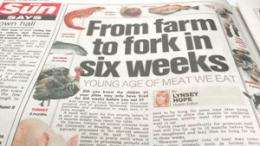How animals go from farm to fork in 24 hours

The world is eating more meat than ever before. But how much do we really know how the meat on our plate gets there?
Aside from the related issues of global food security, impact on the environment and cost, how much do we really know about the lives of the animals we eat on a daily basis?
Dr Darren Juniper, an animal scientist at the University of Reading, said the lifespan of many animals bred for meat was surprisingly short - as is the length of time it can take to get from the farmyard to the dining table.
"The meat industry is pretty swift when it comes to processing animals and getting them from the farm to the supermarket fridge," he said.
"Conventionally-reared chickens have relatively short lives, typically living for just six weeks between hatching and being slaughtered. From the abattoir they can be processed, butchered and packaged in the same day, and could be on the supermarket shelf the following day - meaning they can go from clucking to plucking and cooking within around 24 hours.
"Organically-reared chickens live longer, and usually live for up to 12 weeks before being slaughtered. While some consumers prefer their chickens to have lived for longer, and organic meat has a different composition of fat and muscle, it is a less efficient way of producing meat, requiring more feed for the same weight, and therefore costs significantly more. However, once a chicken is sent to the slaughterhouse, there is little difference between organic and conventional chicken in terms of how long it takes to get to the shops.
"Other animals bred for meat live much longer. Pigs tend to live for four to five months before being slaughtered, with the possibility that fresh pork products can hit the shelves quite soon afterwards. Cured meat, such as bacon, takes around two to three weeks to cure before being ready to eat."
Lamb and beef, however, needs to be hung after the animals are slaughtered to allow muscle to tenderise and become quality meat that people will want to eat, Dr Juniper said.
"Cattle reared specifically for premium beef cuts will live for between 18 months and two years before they are slaughtered, and may then be hung for up to three weeks," he said.
"However, cheaper cuts of beef may come from older animals, such as former dairy animals, potentially being four to five years old.
"Lambs are usually aged between five/six months and one year when they are sent to the abattoir, and the meat then hung for seven to 10 days before it is processed and sold to consumers. Again, older animals can be sold for meat, although sheep which are more than one year old cannot be described as lamb."
Provided by University of Reading

















